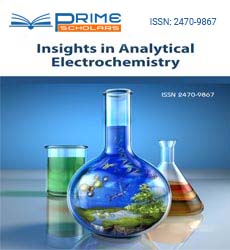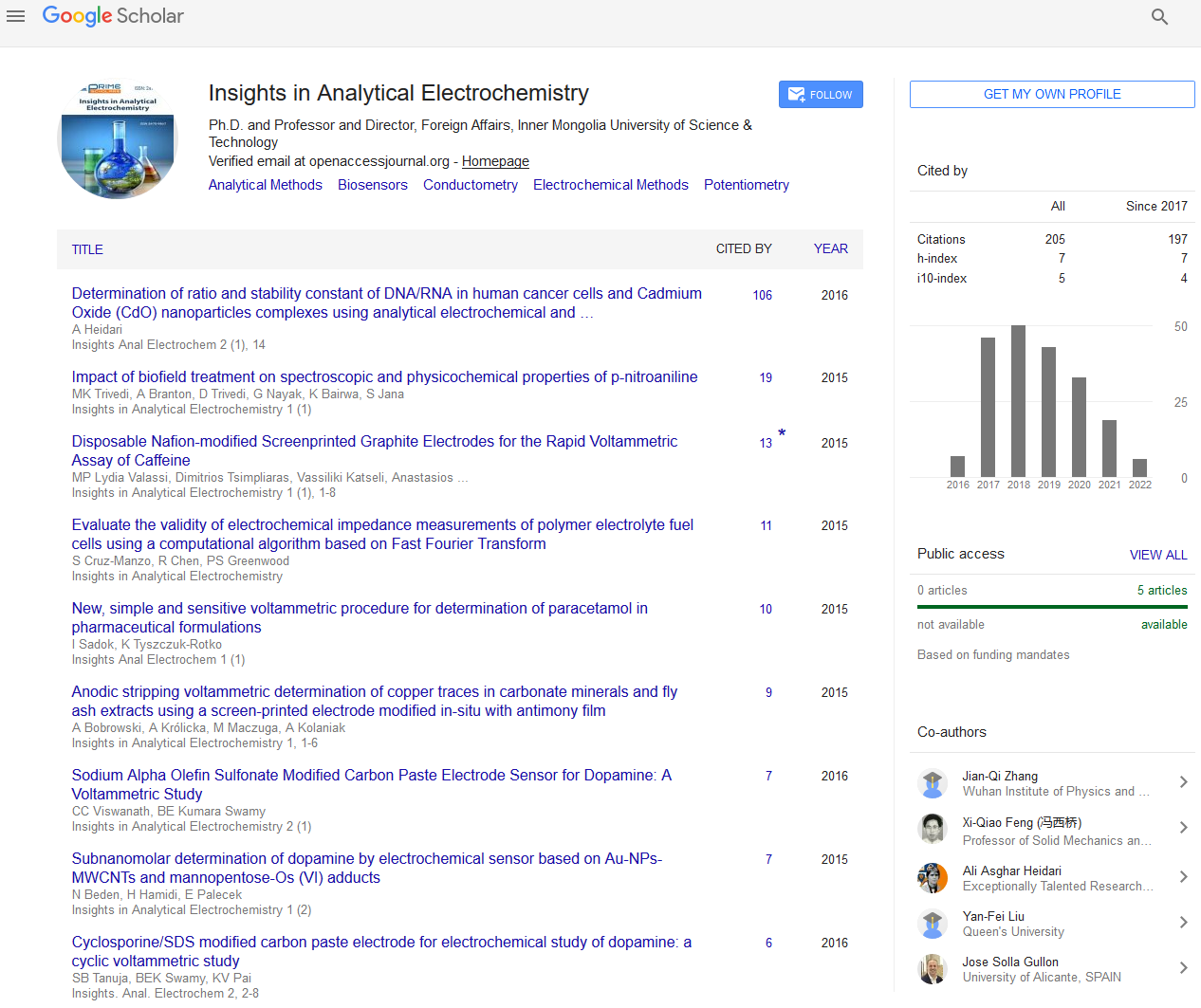Heidari A*
Faculty of Chemistry, California South University, 14731 Comet, St. Irvine, CA 92604, USA
Corresponding Author:
Heidari A
Faculty of Chemistry, California South University 14731 Comet, St. Irvine, CA 92604, USA
Tel: +17754104974
E-mail: Scholar.Researcher.Scientist@gmail.com
Rec date: May 25, 2016; Acc date: May 28, 2016; Pub date: May 31, 2016
Copyright: © 2016 Heidari A. This is an open-access article distributed under the terms of the Creative Commons Attribution License, which permits unrestricted use, distribution, and reproduction in any medium, provided the original author and source are credited.
Editorial
This editorial aims to examine and measure the ratio and stability constant of DNA/RNA in human cancer cells and Cadmium Oxide (CdO) nanoparticles complexes achieved from analytical electrochemical and UV–Vis spectroscopic techniques using the sort of Cadmium Oxide (CdO) nanoparticles in an aqueous environment which have been previously reported in many international reputed journals by researchers and scientists in all over the world [1-19]. For this purpose, by the use of analytical electrochemical and UV–Vis spectroscopic techniques at room temperature about 20°C and under conditions of an ionic strong Sodium Perchlorate (NaClO4) solution and also in an appropriate pHs range in the acidic stable environment, the ratio and stability constant of DNA/RNA in human cancer cells and Cadmium Oxide (CdO) nanoparticles complexes which is one of the most important structural, thermodynamic and spectroscopic relations was determined and calculated. Furthermore, the structural, thermodynamic and spectroscopic characteristics and properties of Cadmium Oxide (CdO) nanoparticles which can be placed as oximetal in the center of DNA/RNA group in human cancer cells complexes were studied.
On the other hand, the above mentioned ligands (DNA/ RNA) in human cancer cells and also in the different pHs ranges have got various kinds of ions and molecules. The scientists and researchers attempt to measure accuracy and precision of these pHs ranges strength. Therefore, firstly, protonation at room temperature about 20°C and an ionic strong Sodium Perchlorate (NaClO4) solution against 0.1 (M) Sodium Hydroxide (NaOH) solution was investigated. Then, by the use of analytical electrochemical and UV–Vis spectroscopic techniques, in the approximate range of pH from 3 to 7 based on A=f (pH) in different strengths of ligands (DNA/RNA) in human cancer cells and with a specific procedure molar absorption coefficient, the ratio and stability constant of Cadmium Oxide (CdO) nanoparticles complexes according to the molar ratio procedure with the combination of protonation stability was calculated and determined. It should be noted that determination and calculation of ratio and stability constant of DNA/RNA in human cancer cells and Cadmium Oxide (CdO) nanoparticles complexes in different pHs ranges and according to the above mentioned conditions using analytical electrochemical and spectroscopic techniques is possible and computable. Considering protonation (L), using calculation of all variations in different pHs ranges in details and also regarding to the experimental and computational results, it can be concluded that dominant formula of DNA/RNA in human cancer cells and Cadmium Oxide (CdO) nanoparticles complexes is ML in the approximate range of pH from 3 to 7.
References
- Huanshun Y, Yunlei Z, Bingchen L, Xue L, Zhiqing Y, et al. (2016) Photoelectrochemicalimmunosensor for microRNA detection based on gold nanoparticles-functionalized g-C3N4 and anti-DNA:RNA antibody. Sensors and Actuators B: Chemical 222: 1119-1126.
- Wu L,Qi P, Fu X, Liu H, Li J, et al. (2016) A novel electrochemical PCB77-binding DNA aptamer biosensor for selective detection of PCB77. Journal of Electroanalytical Chemistry 771: 45-49.
- Zeng Y, Qi P, Wan Y, Zhang D (2016) Sensitive quantitative detection of bacterial DNA based on lysozyme signal probe and Exo III-aided cycling amplification reaction. Sensors and Actuators B: Chemical 231: 675-679.
- Lin X, Sun X, Luo S, Liu B, Yang C (2016) Development of DNA-based signal amplification and microfluidic technology for protein assay: A review. TrAC Trends in Analytical Chemistry 80: 132-148.
- Diculescu VC, Chiorcea-Paquim AM, Oliveira-Brett AM (2016) Applications of a DNA-electrochemical biosensor. TrAC Trends in Analytical Chemistry 79: 23-36.
- Zhu Y, Hu XC, Shi S, Gao RR, Huang HL, et al. (2016) Ultrasensitive and universal fluorescent aptasensor for the detection of biomolecules (ATP, adenosine and thrombin) based on DNA/Ag nanoclusters fluorescence light-up system. Biosensors and Bioelectronics 79: 205-212.
- Evtugyn G, Hianik T (2016) Electrochemical DNA sensors and aptasensors based on electropolymerized materials and polyelectrolyte complexes. TrAC Trends in Analytical Chemistry 79: 168-178.
- Songjaroen T, Feeny RM, Mensack MM, Laiwattanapaisal W, Henry CS (2016) Label-free detection of C-reactive protein using an electrochemical DNA immunoassay. Sensing and Bio-Sensing Research 8: 14-19.
- Ma C, Lin C, Wang Y, Chen X (2016) DNA-based ATP sensing. TrAC Trends in Analytical Chemistry 77: 226-241.
- Huang KJ, Shuai HL, Chen YX (2016) Layered molybdenum selenide stacking flower-like nanostructure coupled with guanine-rich DNA sequence for ultrasensitive ochratoxin A aptasensor application. Sensors and Actuators B: Chemical 225: 391-397.
- Hu Q, Kong J, Li Y, Zhang X (2016) A signal-on electrochemical DNA biosensor based on potential-assisted Cu (I)-catalyzed azide-alkyne cycloaddition mediated labeling of hairpin-like oligonucleotide with electroactive probe. Talanta 147: 516-522.
- Wu D, Li C, Hu X, Mao X, Li G (2016) Electrochemical detection of DNA 3′-phosphatases based on surface-extended DNA nanotail strategy.Analyticachimicaacta 924: 29-34.
- Lee J, Yim Y, Kim S, Choi MH, Choi BS, et al. (2016) In-depth investigation of the interaction between DNA and nano-sized graphene oxide. Carbon 97: 92-98.
- Li H, Wang S, Wu Z, Xu J, Shen G, et al. (2016) New function of exonuclease and highly sensitive label-free colorimetric DNA detection. Biosensors and Bioelectronics 77: 879-885.
- Jia J, Feng J, Chen HG, Luo HQ, Li NB (2016) A simple electrochemical method for the detection of ATP using target-induced conformational change of dual-hairpin DNA structure. Sensors and Actuators B: Chemical, 222: 1090-1095.
- Liao S, Ding H, Wu Y, Wu Z, Shen G (2016) Label-free liquid crystal biosensor for L-histidine: A DNAzyme-based platform for small molecule assay. Biosensors and Bioelectronics 79: 650-655.
- Lu Z, Cheng H, Wang JE, Ren-Jun P (2016) G-QuadruplexDNAzyme Biosensor for Quantitative Detection of T4 Polynucleotide Kinase Activity by Using Split-to-intact G-QuadruplexDNAzyme Conversion. Chinese Journal of Analytical Chemistry 44: 13-18.
- Liu S, Wei W, Sun X, Wang L (2016) Ultrasensitive electrochemical DNAzyme sensor for lead ion based on cleavage-induced template-independent polymerization and alkaline phosphatase amplification. Biosensors and Bioelectronics 83: 33-38.
- Meneghello M, Papadopoulou E, Ugo P, Bartlett PN (2016) Using Electrochemical SERS to Measure the Redox Potential of Drug Molecules Bound to dsDNA - a Study of Mitoxantrone. ElectrochimicaActa 187: 684-692.

